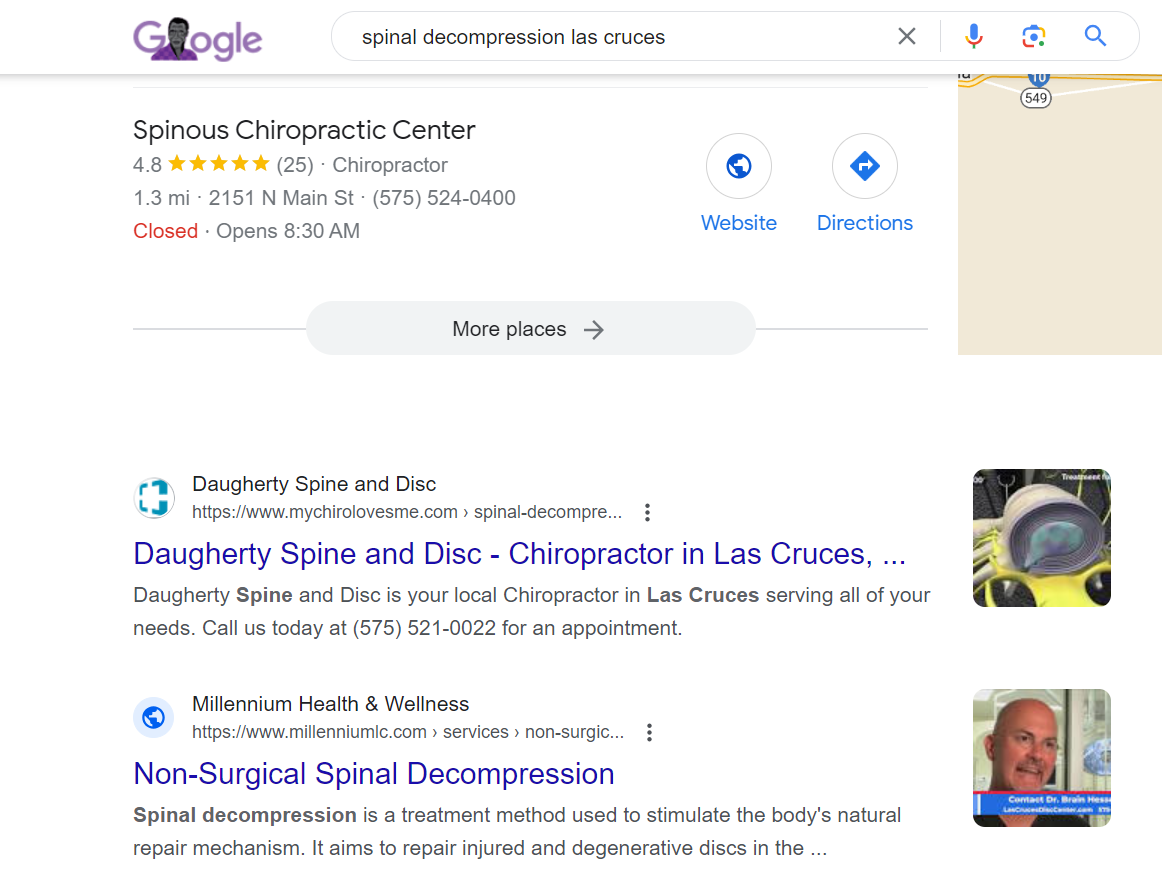I’m really into chiropractic marketing, and one cool thing that’s helping a lot of people is spinal decompression. It’s like a super effective therapy for folks dealing with stuff like herniated discs, sciatica, and constant back pain.
Basically, it’s a way of gently stretching the spine to ease the pressure on squeezed nerves. This awesome technique gives hope to tons of people who just want relief from these tough symptoms.
However, with an increasing number of chiropractors adding spinal decompression services to their repertoire, it is crucial to implement effective marketing strategies to stand out from the competition.
Now, why is marketing so important? Well, it’s like the key to getting more people to notice your chiropractic skills and see you as the go-to person for spinal decompression.
So, I’ve got these five killer strategies that I know will make a big difference. I’ll share them with you because they’re not just ideas; they’re proven ways to get your name out there and attract more people to your practice.
So whether you’re a seasoned practitioner seeking fresh insights or just starting out, keep reading to discover how strategic marketing can help take your chiropractic practice to new heights.
Let’s dive into the top five proven marketing strategies that are sure to attract more patients through your doors!
Dominating Google Through SEO

The first proven strategy I’m going to share for spinal decompression marketing is SEO. Establishing a robust online presence is crucial for businesses, especially in the healthcare sector like spinal decompression clinics.
Let’s explore how this approach can elevate your spinal decompression practice.
SEO involves optimizing your website to rank higher on search engine results pages (SERPs). Google sets the standard for SEO, aiming to make your clinic’s website more visible to potential patients actively seeking spinal decompression services.
At the core of SEO is strategic keyword use. Thorough research helps identify terms and phrases potential patients might use when searching for spinal decompression services. Integrating these keywords naturally into your website’s content, meta descriptions, and headers signals to Google that your content is relevant.
Fine-tuning your website’s structure is crucial for on-page optimization. This includes creating user-friendly, easily navigable pages. Crafting effective page titles, meta descriptions, and header tags, along with optimizing images and ensuring a mobile-friendly design, contributes to a positive user experience and higher search engine rankings.
Google rewards websites that offer valuable, relevant, and authoritative content. Regularly updating your site with informative articles, blog posts, or videos related to spinal decompression engages your audience and signals search engines that your site is a valuable resource.
Earning backlinks from reputable sources enhances your website’s credibility. Collaborating with healthcare professionals, writing guest posts, or participating in community events helps build a network that links back to your site.
SEO is an ongoing process. Regularly monitoring your website’s performance through analytics tools and adjusting your strategy based on the evolving digital landscape ensures your clinic remains visible in search engine rankings.
Targeted Advertising Campaigns
One of the most effective strategies to promote your spinal decompression services is through targeted advertising campaigns.
By utilizing various advertising channels such as Google Ads, Facebook Ads, or TikTok ads, you can reach a specific demographic that is more likely to be interested in your services.
When creating a targeted ad campaign, it’s important to determine your ideal customer profile and narrow down your audience accordingly.
For example, if you specialize in treating athletes with spinal injuries, you can target sports enthusiasts or fitness groups on social media platforms like Facebook.
This focused approach allows you to maximize the effectiveness of your marketing budget by reaching out to those who are already interested in what you have to offer.
For an advertising campaign to be successful, it’s crucial to create compelling ad copies and captivating visuals that grab the attention of potential customers.
Your ads should highlight the benefits of spinal decompression therapy and address common pain points that people might experience.
Whether it’s showcasing before-and-after images or featuring testimonials from satisfied patients, visual content plays a vital role in capturing audience interest and driving conversion rates.
So leveraging targeted advertising campaigns can attract potential clients.
See related post: Neuropathy Marketing Ideas to Attract New Patients in 2024
Leveraging Patient Testimonials and Before After Case Studies
Patient testimonials can be a powerful tool in gaining the trust of potential patients. When someone is considering spinal decompression therapy, they want to know that others have had positive experiences with the treatment.
So sharing success stories and testimonials from satisfied patients can help you build credibility and showcase the effectiveness of your services.
One way to leverage patient testimonials is by featuring them prominently on your website or social media platforms.
This allows potential patients to read real-life accounts of how spinal decompression therapy has improved the lives of others.
To make these testimonials even more impactful, consider including before and after photos or videos that demonstrate the transformation achieved through the treatment.
Before-after case studies are another excellent way to showcase successful outcomes and encourage inquiries.
These studies present detailed information about a specific patient’s condition before starting spinal decompression therapy and highlight the improvements they experienced as a result of the treatment. Including objective measurements like pain reduction, increased range of motion, or improved quality-of-life indicators can add credibility to these case studies.
When collecting testimonials ethically within legal guidelines, it’s important to ensure that all statements made by patients are true and accurate representations of their experience with spinal decompression therapy.
Obtain written consent from each patient before using their testimonial publicly, clearly disclosing if any compensation was provided for their participation.
As always, consult with legal counsel familiar with healthcare marketing regulations in your jurisdiction for guidance on how best to collect and utilize patient testimonials legally.
In a nutshell, sharing real success stories and before-after case studies helps inform potential patients about the benefits of spinal decompression therapy and builds trust in your practice.
Networking & Referral Programs

Networking plays a crucial role in the success of any healthcare practice, including those focused on spinal decompression therapy.
Establishing strong connections with other healthcare professionals in your community can expand your reach and attract more patients to your practice.
One effective way to network within the healthcare community is by attending conferences, seminars, and workshops that are relevant to spinal decompression or chiropractic care.
These events provide opportunities to connect with like-minded professionals, exchange ideas, and potentially form referral partnerships. Getting involved in professional organizations related to chiropractic or spine health can also enhance your networking efforts.
In addition to networking, implementing a referral program within your practice can be a powerful marketing strategy. Satisfied patients are often eager to spread the word about their positive experiences with spinal decompression therapy.
Consider offering discounts on future treatments or complimentary appointments for each successful referral made by an existing patient.
This not only rewards loyal patients but also helps build trust and credibility among potential new clients who receive recommendations from people they know and trust.
Another proactive approach would be hosting workshops or seminars jointly with other healthcare providers such as physical therapists or orthopedic surgeons who frequently collaborate with chiropractors specializing in spinal decompression therapy.
This collaborative effort allows for cross-referrals between practices while educating attendees about the benefits of spinal decompression treatment options.
Implementing these strategies will help position your practice as an authority in spinal decompression therapy while leveraging synergies within the larger network of healthcare professionals.
Content Marketing and Thought Leadership
 Content marketing has now become a powerful tool for businesses to establish themselves as thought leaders in their respective industries.
Content marketing has now become a powerful tool for businesses to establish themselves as thought leaders in their respective industries.
For spinal decompression practitioners, creating quality content through blogs, articles, or videos can offer significant value. By sharing valuable insights about spinal decompression therapy and related topics, chiropractors can position themselves as experts in the field.
One of the key benefits of content marketing is that it allows professionals to educate their audience on the various aspects of spinal decompression therapy.
By providing informative and helpful content regularly, practitioners can build trust with potential clients who are seeking solutions for their back pain or other related conditions. This helps in establishing credibility and positioning the practice as a go-to resource for reliable information.
Consistency is crucial when it comes to content creation. Regularly posting new articles or releasing informative videos not only keeps your audience engaged but also demonstrates your dedication towards educating them.
It’s important to maintain relevancy by addressing current trends or hot topics within the industry. This shows that you stay updated with advancements in spinal decompression therapy and positions you as an authority figure among your peers.
To enhance your thought leadership efforts further, consider collaborating with other experts or influencers in the field. Hosting guest blog posts from renowned chiropractors or featuring interviews with notable professionals can provide diverse perspectives while enhancing your credibility even more.
Conclusion
In conclusion, implementing effective marketing strategies is crucial for promoting spinal decompression services.
By focusing on building a strong online presence through targeted advertising, engaging social media content, and search engine optimization, practitioners can expand their reach and attract new clients.
Additionally, offering informative webinars and educational content can help establish credibility and trust in the community.
Leveraging patient testimonials and success stories can further enhance the reputation of a spinal decompression practice.
By combining these proven marketing tactics, practitioners can effectively showcase their expertise and attract a steady stream of patients seeking relief from spinal issues.
It’s time to take action and apply these strategies to grow your spinal decompression business!


